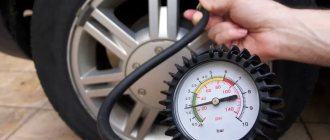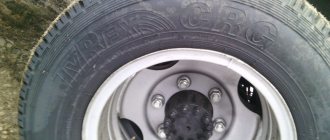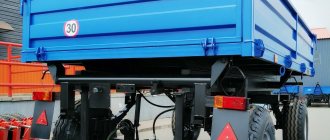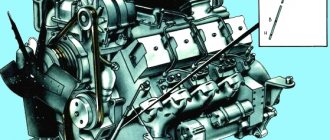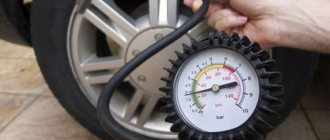Tires absorb shocks from road unevenness, significantly unloading the suspension parts.
Modern cars are equipped with pneumatic tires, which can be tubed or tubeless.
On GAZ-53A, GAZ-51A and ZIL-130 vehicles, a tube tire is used, consisting of a tire, a tube with a valve and a rim tape that protects the tube from abrasion by the wheel rim and pinching by the edges of the tire.
Tire section
Tire cut:
1 — bead core (wire ring); 2 - sidewall; 3 - frame; 4 - cushion layer; 5 — protector; 6 - board.
The tire consists of a frame 3, a cushion layer 4, a tread 5, sidewalls 2 and beads 6.
The frame is made of several layers of rubberized fabric
- cord and firmly attached to the rigid beads that secure the tire to the wheel rim. The sides are embedded with cores (rings) made of steel wire wrapped in tape. The rings prevent the beads from stretching and prevent the tire from slipping off the wheel.
The cushion layer of rubber lying between the tread and the frame protects the latter from damage. The tread pattern depends on the purpose of the tire.
Camera
- a closed rubber sleeve into which air is pumped through a valve built into it - a valve that allows air only into the chamber.
Valves
Valves:
a - metal; b - rubber-metal;
1 - body; 2 — cap-key; 3 - nipple; 4 - valve; 5 - spring; 6 - sealing washer; 7 - camera; 8 — valve washer; 9 - nut; 10 - rubber body.
Main valve parts
- a rubber-metal or metal body, a spool consisting of a nipple and a valve with a spring, and a cap. When the tire is inflated, the valve opens from the air pressure, overcoming the elastic force of the spring, and when the air supply stops, the spring closes the valve and, therefore, the release of air from the chamber becomes impossible.
To make it easier to inflate air with a tire pump, the tip of its hose is equipped with a rod, which, when connecting the hose to the valve, forcibly opens the valve. When the hose tip is unscrewed from the valve, the valve is released.
Tire sizes
Tire sizes:
D—outer diameter; d—inner diameter; B and H are the width and height of the profile.
Their dimensions in inches or millimeters are marked on the side surface of the tire and tube. The first number indicates the width of the profile B, the second - the diameter d of the wheel rim.
Tire sizes and air pressure are shown in the table.
| Automobile model | Tire designation1 | Tire air pressure, kn/m2 (kgf/cm2) | |
| front wheels | rear wheels | ||
| GAZ-53A | 240 — 508 (8,25 — 20) | 280(2,8) | 430(4,3) |
| GAZ-51A | 220 — 508 (7,50 — 20) | 300(3,0) | 350(3,5) |
| ZIL-130 | 260 — 508 (9,0 — 20) | 350(3,5) | 500(5,0) |
| "Moskvich-412" | 155 — 330 (6,00 — 13) | 170(1,7) | 170(1,7) |
| 1 The designation in inches is given in parentheses. | |||
For a GAZ-53A car, the tire is mounted on a disk with a wide rim, which is held on it by one bead and a locking ring.
On a GAZ-51A car, the tire is held on the rim by two rings:
side and lock.
Wheel disc with a flat rim of a GAZ-51A car
Wheel disc with a flat rim of the GAZ-51A car:
1 - rim; 2 — disk; 3 — removable side ring; 4 - locking ring.
Tube or tubeless tires are installed on the one-piece deep rim of the wheel of the Moskvich-412 car. A tubeless tire does not have a tube, and air is retained in it due to the tight connection between the tire and the beads of the wheel rim. The valve is installed directly in the rim.
Deep rim wheel rim and tire
Wheel rim with deep rim and tire of the Moskvich-412 car:
1 - camera; 2 - valve; 3 — tire; 4 - rim; 5 - disk.
Tire pressure is checked with a tire pressure gauge.
Arched tires - why are they needed?
For better cross-country ability, there are arched tires. What can you say about them? The distinctive feature of them is a very wide profile - the width of the arched rubber is two or even three times greater than the usual width of an ordinary tire.
Example of arched tires for gas 66
At the same time, the outer size itself remains at a normal level. This design makes it possible to reduce the internal pressure in tires to 0.5-1.4 kgf/cm2, the pressure on the ground is noticeably reduced, distributed over the entire width of the wheel, and due to this, the maneuverability of the equipment is significantly increased.
Tire pressure
Pressure sensor for GAZ 53
The tire pressure of a GAZ 53, a dump truck with radial wheels, must correspond to the following indicators:
- for the front wheels the required air pressure is 390 kPa,
- for rear 620 kPa.
In the case of diagonal ones, slightly different values are relevant, namely:
- for front wheels 280 kPa,
- for rear 500 kPa.
Truck GAZ 53
If the pressure in the GAZ 53 tires is less than these values, it means that they will wear out faster, road grip will be reduced and the car will skid to the side from time to time. It is very risky to drive a car whose tires have less than recommended air pressure. It is pointless to hope that a truck will remain stable due to its weight.
If these values are exceeded, nothing good should be expected either. If you fall into a hole, you can damage the disk. Road grip levels are also reduced.
When buying tires on Avito or at a car market, you can count on the air pressure being normal and the spare tire being ready for use. But is this always the case? It's easy to check how many atmospheres there are. This service is available at many gas stations.
The main thing is to let the car cool down a little after driving. This is a prerequisite for obtaining an objective assessment of the situation. How many atmospheres are in the rubber depends on the temperature of the pumped air and neighboring parts. As they move, they heat up and the pressure increases. If you immediately inflate or lower the wheels, they will last longer.
Tire care
To increase tire life you must:
- inspect the tires daily to ensure there are no cuts, tears or visible damage;
- remove sharp objects from the tread and stones, bricks, etc. stuck between the dual tires of trucks; maintain normal tire pressure; timely rearrange wheels and tires according to the scheme. The durability of tires can be significantly increased if you follow the rules of vehicle operation.
Scheme for rearranging wheels and tires on GAZ-53A and GAZ-51A vehicles
It is impossible to indicate exact values. Drivers must be guided by the data specified in the vehicle passport.
In doing so, they should take into account factors such as:
- quality of road surface;
- car condition;
- season;
- climate (in particular, air temperature);
- type of tires used.
Manufacturers calculate pressure in an effort to reduce tire wear and fuel consumption. This approach, if there are a lot of bumps and potholes, will lead to excessive shaking and loss of dental crowns. The optimal pressure will have to be determined directly by the vehicle owner.
The main thing is not to exceed the maximum values indicated on the side of the tire. Otherwise, serious problems with driving the car cannot be avoided. Low pressure provokes an increase in braking distance. In the absence of appropriate knowledge and experience, the driver should contact a service station specialist.
The pressure in GAZ 66 and 53 tires is of great importance. If the tires are not inflated correctly, the proportionality of the load on the rear of the truck will be disrupted. To prevent vehicle malfunctions, air density must be checked regularly. First, the pressure is checked when the car's tires are cool. The air inside the tires compresses and expands. These changes are caused by temperature. A long ride can increase tire pressure by up to 25%.
From the history of the creation of GAZ - 66
The GAZ-66 was launched into mass production in 1964. It was created on the basis of the GAZ-62 and GAZ-63 trucks. The all-wheel drive truck had a payload capacity of 2 tons, a V-shaped eight-cylinder gasoline engine and a 4-speed gearbox. In 1968, a tire pressure regulation system was added to the GAZ-66 design. The model was twice awarded gold medals and received a quality mark. The production of GAZ-66 ceased in 1995, at the moment you can purchase GAZ 66 from military conservation.
Due to what the high cross-country ability of GAZ - 66 was achieved
A number of factors influenced the truck’s high cross-country ability. First of all, this is the use of self-locking differentials in both axles of the car. It is important to shift the center of gravity to the middle of the body, which gives an even distribution of the load on both axles of the car.
Detailed diagram of the GAZ 66 truck The high landing of the body allowed the truck to crawl through swampy terrain without touching the bumps and hummocks with its “belly”. Also, due to the short overhangs, the GAZ-66 truck easily overcomes uneven sections of the road. Tires also affected cross-country ability. It’s worth talking about tires in more detail.
The lineup
The GAZ 53 family includes medium-duty trucks equipped with an eight-cylinder engine. The first models were released in 1961; production of cars from this series was stopped in 1993. They were replaced by a GAZ 3307 car.
Among the main modifications of this truck there are both civilian and military versions. A separate category includes dump trucks, the KAVZ-685 bus and models that operate on liquefied gas.
GAZ 66 began production in 1964. All-wheel drive cabover trucks were developed for the military. They are characterized by high all-terrain qualities.
They are explained by the presence of the following features:
- self-locking axle differentials;
- high ground clearance;
- centralized system for regulating air density in tires;
- four-wheel drive.
About the history of the legendary truck and its features
Unlike all previously developed trucks of the Country of Soviets, the GAZ-53 was originally created purely for the needs of the national economy. In case of war, it was not planned to mobilize it into troops and use it to transport guns, transport ammunition, wounded, etc. army needs. In this regard, the GAZ-53 can rightfully be called the first domestic “NOT dual-use” truck.
This explains the “cheerful” colors of the legendary car. If previously all trucks of the Soviet Union were painted only in a dark green protective color, then the 53rd from the very beginning was distinguished by a very diverse range of colors: its cabs were painted in blue, gray, blue, beige, red, green, yellow, orange and some others colors.
The direct “relative” and “ancestor” of the GAZ-53 was another all-Union hard worker - the GAZ-51 truck. The development of a new generation truck was led by the chief designer of the Gorky Automobile Plant, Alexander Dmitrievich Prosvirnin (1914-2005). By the way, he was in 1946-1947. participated in the development of the GAZ-51, then still in the role of an ordinary designer.
During the summer/autumn of 1961, a pilot batch of GAZ-53F trucks was subjected to serious tests, the main of which was a motor rally along the route Moscow - Tashkent - Moscow, with a total length of ten thousand kilometers. The trucks were driven intensively along country roads and real deserts, steppe sands, marshy soils and mountainous areas. The culmination of the route in Central Asia was the Shahristan pass, in Tajikistan, located at an altitude of more than 3.2 thousand meters above sea level.
At the same time, 2 GAZ-53Fs were mercilessly exploited in the Moscow region, in off-road rural conditions, and 4 more were driven along the Moscow-Gorky highway back and forth until the figure of 15,000 km was reached on their speedometer, testing reliability on main lines. In total, each of the vehicles performed 18 flights.
Tread pattern
It is difficult to buy winter tires with studs for GAZ 53. Mostly the classic herringbone pattern is offered. All-season ones are available, which simplifies car care. If the Christmas tree is made of a material designed to withstand heat from friction, frost in winter, and sliding, then you can change the rubber only when the treads are worn out.
But you always need to take into account the dimensions, diameter and width. There is no alternative in the table of interchangeable wheels. If you don’t forget to check the pressure in the GAZ 53 tires, the service life will be as long as possible.
Possible problems
Due to improperly inflated wheels, vehicle handling suffers, extraneous noise and shaking occur, and tire wear increases. There may be malfunctions in the operation of the vehicle's chassis.
Many drivers note that if the GAZ is on low-pressure tires, they can avoid discomfort when driving on a bad road. In the current circumstances, insufficient tire inflation provides increased smoothness of movement and braking accuracy.
Wheels should only be inflated when they are “cold”. Otherwise, it will be impossible to assess the pressure level.
The pressure in GAZ 66, 53 and 3110 tires is determined according to the table. Among the criteria taken into account are tires (their type), the presence or absence of load, and the location of the wheels. The developed recommendations can be found in the documents attached to the TS.
Truck tires for GAZ 53 are a work of art. They must withstand enormous weight. It is believed that in the USSR they only made reliable things, but now they have forgotten how. It makes me sad to think about it. It’s better to hope that this is not the case, because the safety, life and health of people depend on the quality of tires.
It's important to buy good ones. Some ridiculous statement, a joke on the topic of the day can interfere with choosing the right ones. If you brush aside this obsessive thought and concentrate on the main thing, you will be able to find what you are looking for.
